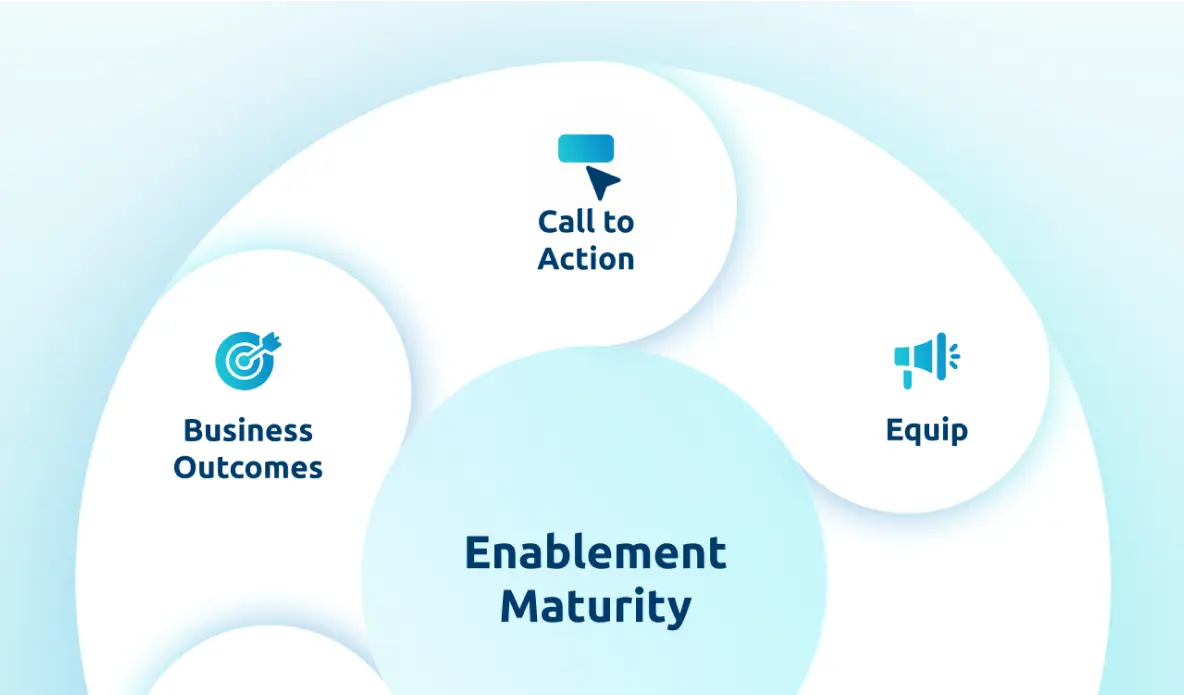According to research conducted by Sales Enablement PRO, organizations with dedicated enablement efforts report a nine percentage-point increase in average win rates compared to organizations that do not have dedicated enablement efforts. So how can you make sure that your enablement strategy is setting your organization up for repeatable success?
Shawnna Sumaoang: Hi, and welcome to the Win Win Podcast. I’m your host, Shawnna Sumaoang. Join us as we dive into changing trends in the workplace and how to navigate them successfully.
Here to discuss this topic is Gail Behun, the director of revenue enablement at LivePerson. Thank you for joining us, Gail. I’d love for you to tell us about yourself, your background, and your role.
Gail Behun: Thanks for having me. So I have been here at LivePerson only a couple of months, but I’ve been in revenue enablement for about ten years. I started off as a seller and became a sales leader, and then really found the impact of sales enablement to be so powerful on the entire org. And I’m incredibly passionate about empowering salespeople and associated teams to be as efficient, and as effective as possible.
SS: I love that. On that note, I think one of the things that stood out on LinkedIn, you also mentioned your passion is around building really scalable and repeatable sales success. In your opinion, what role does enablement play in driving that for the business?
GB: I think we have to be the cheerleaders for scalable and repeatable. I think our sales leaders are very good at solving individual problems, individual quota issues, and individual deals, but enablement is well suited to look big picture at the processes and tools that we have in place that make that process repeatable. Revenue enablement has the opportunity to really streamline the effectiveness of our sellers through our tools, our talk tracks, and our training. And we’re uniquely positioned to do that because we’re not involved in a deal. We’re involved in every deal on some level.
SS: Absolutely. Now, I know you all just implemented Highspot, but prior to that, your team had multiple separate tools to deliver enablement programs. What were some of the challenges that your organization faced with that approach?
GB: I think every organization is faced with the dreaded G-drive scope creep, where there are ten versions of this, and nine versions of this, and one lives on this drive, and this rep has downloaded the deck, and now they’re making changes on their own, and there just wasn’t tight governance. And as organizations grew, especially radically during COVID, it just got out of control.
Having a unified tool became a must-have as we and a lot of other companies have taken a slowdown in hiring and an opportunity to reset our systems moving forward.
SS: Absolutely. From your perspective, how does having a unified enablement platform help you to overcome some of the challenges to your earlier point around being able to drive scalable and repeatable sales success?
GB: My goodness, the amount of time sellers spend not selling is upwards of 70%. It’s just crazy the amount of time that they spend getting deals through the process and looking for materials and where we can cut that time down and make them more efficient. Gives them that time back to be more customized in their engagements with their customers and be able to expand their business offerings and value rather than working through cumbersome systems. And so a single source of truth is critical to that. And that’s what a unified tech stack provides. It was one of the biggest reasons for us moving to Highspot, but the bigger reason is the buyer’s experience and the Digital Sales Rooms, and having those both under one company umbrella made it a win for us.
SS: I love that. Now, another key reason your team decided to implement Highspot was to reinforce the value of enablement as really a strategic tenant for the business. What are some of the strategic initiatives that enablement supports at LivePerson and how will you leverage Highspot to help?
GB: Our team is relatively new. LivePerson went through an enablement reset. Because so much of our sales motion is grounded in the expansion phase, so much of our initiatives this year are around account expansion. And, as I said, Digital Sales Rooms are a game changer when it comes to interacting with existing customers and showing ongoing value.
And so the ongoing value metric is incredibly important for us as we double down on that facet of our business. It also helps us dramatically when you’re talking about multi-threading and getting into additional stakeholders because with existing accounts it’s very easy to have one great champion but not go deeper than that, and Digital Sales Rooms and the engagements we have through Highspot will allow us to have more powerful multi-threading and more opportunities to open more doors within our client account.
SS: I love that. I think that’s a great initiative and a way for Highspot to help support that. Now, I know one of your goals in implementing Highspot was also to ensure a really strong alignment with marketing. What are some of your best practices for collaborating with marketing and how are you driving strong alignment through Highspot?
GB: Yeah, I don’t think there’s anything more important than making sure our sellers are up on those marketing messages because those marketing messages, that’s what marketing is talking to our accounts and our customers out in the space about, it’s what we’re known for being thought leaders: having great analytics and information. So, having a single point for that information within Highspot is incredibly important.
Our marketing team and our field marketing team each have their own sections: field marketing, especially because we do a ton of customer-facing events, and so for them to organize that for all of the sellers to see where they’re going to be out live and in person, “What type of events? What are the talking points?” Become critical as well. Sellers, even before pre-COVID when we were all at home, but especially now, we have to be able to tell each other’s stories. And so marketing is great at collecting those stories. They’re telling customer stories through case studies. Enablement, we’re telling customer stories through what we call win stories, which are more behind the scenes.
So we’re creating win stories that let us interview a seller, tell the good, bad, the ugly, and then we can tie those to those case studies. And so it gives the sellers the information they need to go out to market, but also to have the conversations behind the scenes.
SS: Fantastic. Now, as we mentioned early on, you have started the work of establishing a great foundation in your implementation, and I know that you’ve just launched Highspot to your teams. What were some of your best practices to ensure a successful launch? And how are you measuring success?
GB: We had an amazing CSM implementation manager on the Highspot side who gave us some great advice, and we did a lot of ramp-up activities. We had a cheerleading squad with internal leaders who were making videos that were hosted on the Highspot page, talking to our potential users, saying, “Here’s what you’re going to love about it, here are some ways you’re going to use it.”
We wrangled in our frontline managers and our leaders to speak to why we made this move, making sure that they didn’t feel like it was just another piece of software we purchased, and that this was critical to the way that they did their jobs. Our senior project manager on the project gamified a great deal of the onboarding.
And so you could get points for different activities and she would post out the winners. And we’re not done. We’re going to continue to share those videos over the next couple of weeks. We launched Highspot at the same time, right before our sales kickoff. And so our sales kickoff pre-work was actually to create a video and host it on Highspot.
I got everybody in and using the tool. And now we have these great videos people have made that we’re scoring and we’re going to give prizes out over the next couple of weeks. So we are going to continue to hype this. We’re going to do some, sharing and awards for a great Digital Sales Room or a great engagement that somebody’s utilized the site for, to show those best practices.
And then continuing education. We just have to continue to have office hours, see what kind of questions people are asking, and make sure the site is answering those so that we can make sure we continue to build it out. We’ve launched it, but honestly, I think we’re probably 30 to 40 percent done, meaning we have a lot more to do, and that next phase is going to be driven by more interactive content, more video content, and more user-driven content as they push us to add and make more valuable for the site.
SS: And one area in particular, because you’ve mentioned it early on in the conversation where I know you aim to achieve strong adoption is in the use of digital rooms. As you’ve mentioned, it’s a great way to get deeper into the accounts that your team’s going after. How do you plan on driving adoption of Digital Rooms with your revenue-facing teams?
GB: That’s a great question. Partially by cheerleading it through their front-line managers, making sure their front-line managers are asking, Hey, here’s this deal you have in play. Let’s look at your Digital Sales Room. Let’s look at it together. Let’s see where you’re getting engagement. As I said, the post-sale motion is a big part of what we do.
So working with our CSMs. Have you launched a room? What’s the engagement you’re getting? Not just right before your QBR, but on an annual basis. And so really working with our frontline managers to be our champions in those areas, I think is going to be the biggest push. And then again, showcasing good successes, being able to show, “Hey, this account has a very high level of usage of their room.”
We’ve got a great number of downloads. We’re seeing a lot of multiple people logging in and show that as a best case so that we can continue to say, “Hey, don’t you want to have that engagement for your accounts?”
SS: I love that. Now, again, I know that LivePerson is just at the start of its enablement journey with Highspot, but what are some of your key goals for enablement in the year ahead? And how do you plan to leverage Highspot to help you get there?
GB: One of our key goals I’ll speak to is just what I would call a brand unification. LivePerson went through a lot of twists and turns over the last couple of years. And so having a strong unified message is going to be incredibly important.
So working with our marketing team to have a great unified message for our brand to be able to gamify that through some sales contests where we can have people upload elevator pitches and point of view decks and things like that, where they’re talking to the brand, they’re saying the words that we need them to say in the way that we need them to say it is going to be one of our key goals. Engagement within our accounts going deeper and wider, and we’ll be able to measure that through the Digital Sales Rooms and the adoption in those spaces. And then account retention is one of our biggest goals – retention and expansion. And so again, we’re pushing home on the backside of usage, whether it’s for QBRs and beyond, to make sure that we have as much engagement as possible year-round.
So how do we make sure that a Digital Sales Room isn’t opened and then we have a client login, they do their QBR and then they don’t look at it for six, seven months? So, consistent engagement is going to be important because that’s the motion of selling 365 days a year is what makes a difference. When you come up to renewal with an account, have you added value all year? And using these rooms is going to let us see that we’re giving that value out to our customers in a tangible way.
SS: I love that. Gail, thank you so much for joining us today. I really appreciate the time.
GB: Thank you.
SS: To our audience, thank you for listening to this episode of the Win podcast. Be sure to tune in next time for more insights on how you can maximize enablement success with Highspot.



